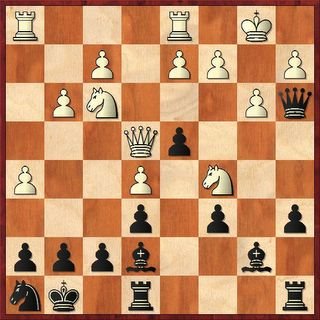Rogers,E - Prong,C (1904) [C57]
Brand New Day Cafe, 04.20.2006
Two Knight's Defense: Ulvestad Variation [C57]
1.e4 e5 2.Nf3 Nc6 3.Bc4 Nf6 4.Ng5 d5 5.exd5 b5 6.Nxf7?
Clearly white had better options. Surprisingly, Bf1 is the book response here. 6...Kxf7 7.dxc6+ bxc4
For the knight sacrifice, white has gotten 2 pawns. Furthermore, he has fractured the black queenside pawn structure and destroyed black's hope of castling. However, the pawn on c6 is not long for this game, and the lead that black has in development will not be going away anytime soon.
8.0-0 Qd5 9.Nc3 Qxc6 10.d3 cxd3 11.cxd3
Forced. On Qxd3 comes Ba6 with a skewer of the white queen and rook. I struggled with this move. I knew I wanted to develop a bishop, but finally I decided that Bc5 was stronger because it pinned the f2 pawn.
11...Bc5 12.h3 Bb7 13.Ne4
Taking the e4 knight looked scaryto me because after dxe4 the black king is exposed and the white queen has access to the d-file, in addition to the b3, f3 and h5 squares for potential checks.
13...Rad8
Pinning the d3 pawn, and causing the knight on e4 to become unprotected.
14.Ng5+ Ke7 15.Nf3 Rhe8 16.Bg5 Kf8 17.Be3 Bxe3 18.fxe3 Ba6
Now on Rc1 black plays Qb6, and will threaten the fork of the b2 and e3 pawns, in addition to winning the d3 pawn.
19.Ng5 Kg8
I looked at Bxd3, and it looked very good. However, I decided to get my king tucked away and play it safe, since I was ahead.
20.Rc1 Qb6 21.Re1 Rxd3 22.Qa4 Rxe3 23.Kh1 Rxe1+ 24.Rxe1 Qb5
Since black is up a piece and a pawn it is time to trade off the queens, which should remove most of the drawing chances that white might find.
25.Qa3 Qc6
This move has two purposes. On the surface it seems like it is simply an attempt to control the h1-a8 diagonal and pin the g2 pawn to the king. While that is true, it also has the added benefit of helping to control the square directly in front of the passed pawn. White now hits e4 2 times and gains control of the square so that the e pawn may be pushed one stepped closer to the promised land.
26.Nf3 e4
I wanted to play this move right away, but it is improtant to examine what you give up when you remove a piece from one square to move it to another. In this case I relinquished control of the d4 square. I decided this wasn't critical because I could move my queen to d6 with a gain of tempo, since white probably did not want to trade queens.
27.Nd4 Qd6 28.Qa4 e3 29.Nf5 Qd3
Protecting both the pawn on e3 and the bishop on a6. Furthermore, the queen attacks the knight on f5.
30.Nd4 Re4 31.Rd1

Rxd4
Temporarily giving back some material, but this is inconsequential since black will promote his pawn, and win the game.
32.Qxd4 Qxd4 33.Rxd4 e2

With no hope of stopping the pawn from queening. 0-1






